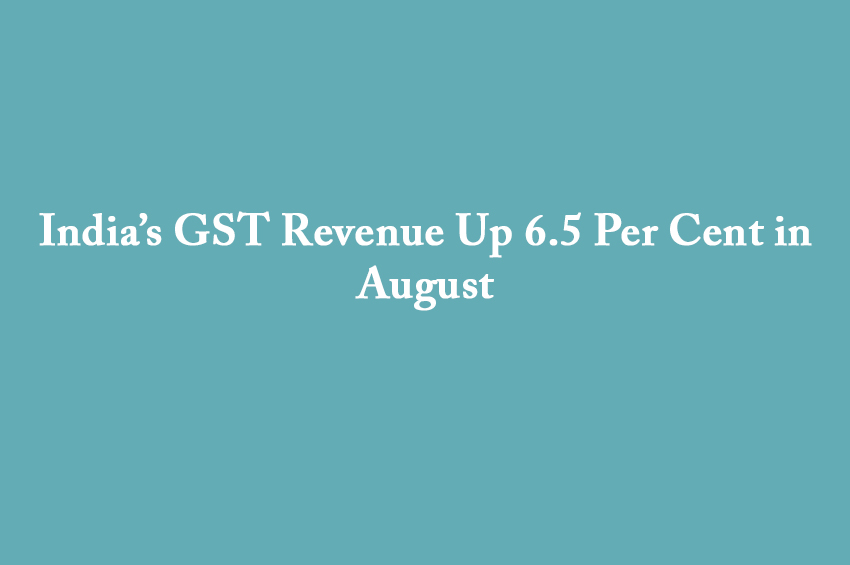Winning Bizness Economic Desk
The country’s Goods and Services Tax (GST) revenue collection stood at Rs 1.86-trillion in August of this year, up 6.5 per cent as compared to the year-ago, official data showed.
Post-refunds, the GST mop-up came to Rs 1.67-trillion which is 10.7 per cent more than the net revenue a year-ago.
Businesses received Rs 19,359-crore as tax refunds in August which is nearly 20 per cent lower than the refunds given in the same time a year ago, the data showed.
In the preceding months, tax refunds have been high. For example, in July, the GST refunds had climbed up 67 per cent from the year-ago period.
In August, the central government collected Rs 31,474-crore as Central Goods and Services Tax (CGST) while the states collected Rs 39,736-crore as State GST (SGST).
Taxes on inter-state sales and imports apportioned among central government and the consuming state stood at Rs 83,964-crore, while the revenue from GST compensation cess was Rs 11,792-crore.
GST revenue collections have, so far, been strong and the monthly average so far this year has been Rs 2-trillion.
Now, a revamp of the GST structure to simplify the tax system is being considered to give tax relief to consumers and make compliance easier.
India’s CEA Retains FY 26 GDP Growth Forecast at 6.3-to-6.8 pc
India’s Chief Economic Advisor (CEA) Mr V Anantha Nageswaran said that the country is likely to attain a GDP growth rate of between 6.3-to-6.8 per cent for this fiscal (FY 26).
This is notwithstanding the high 50 per cent tariffs imposed by US President Mr Donald Trump.
Mr Nageswaran said that taking into account India’s `resilience’ in the first-quarter (Q1) of this fiscal (April-to-June quarter) and the growth rate, the country’s finance ministry has retained its growth rate expectations in the range of 6.3 per cent-to-6.8 per cent for FY 2025-26.
At a press conference recently, Mr Nageswaran said that “despite the reciprocal tariffs and penal tariff (imposed by the US) and after seeing the resilience of Q1 growth, we are retaining the growth rate projection for the current fiscal at 6.3 per-cent-to-6.8 per cent.”
Mr Nageswaran said that the government was not expecting `significant’ downside risks to GDP growth due to the high US tariffs. Its impact on the country’s economy would also be short-lived, he added.
Here, it is important to point out that the Indian economy clocked a 7.8 per cent GDP growth in Q1 FY 26, primarily due to continued lower inflation.
Honda’s August Two-Wheeler Sales Rises 4 pc
Honda Motorcycle & Scooter India (HMSI) has registered a total sale of 5,34,861 units in August of this year. This is a four per cent growth Month-on-Month (MoM) over July’s sales.
The sales comprised 4,81,021 units in the domestic market and 53,840 units in exports.
For the year-to-date period of this fiscal (FY 26), HMSI has achieved a total sale of 24,22,880 units, including 21,73,834 units sold in India and 2,49,046 units shipped overseas.
On road safety initiatives, HMSI organised awareness campaigns across 12 cities including Bangalore, Trichy, Prayagraj, Warangal and Gandhinagar.
Ind Production Climbs to Four-Month High of 3.5 pc in July
July witnessed a northward movement in industrial production to a four-month high of 3.5 per cent from the 1.5 per cent of the previous month of June.
This increase was propelled by a broad-based improvement across all sectors, data released by the National Statistics Office ((NSO) showed.
The Index of Industrial Production (IIP) also revealed that manufacturing output climbed to a six-month high of 5.4 per cent in July from 3.7 per cent in the previous month.
An important point that needs highlighting here is that the electricity sector output too turned positive at 0.6 per cent for the first time in three-months.
Mining output contracted 7.2 per cent in July—it remained in negative territory for the fourth straight month. While the mining and electricity sectors remained weak, there was an encouraging growth in manufacturing output aided by construction inputs and consumer durables.
In July of last year (2024), the IIP had grown 4.98 per cent.
For the first four months of the current fiscal year (FY 26), the IIP growth averaged 2.3 per cent as compared to the 5.4 per cent in the corresponding period of last year.
By use-based classification, all categories registered a modest to reasonable growth in July of this year, except for primary goods where contraction persisted (-1.7 per cent).
What needs highlighting here is the healthy double-digit expansion in the construction goods sector—it grew at the 21-month high of 11.9 per cent in July of this year which is a stand-out performance. Here, it must be noted that the growth was propelled by sustained government capex.
The capital goods output improved to five per cent in July from an eight-month low of three per cent in June which clearly reveals some pick-up in investment activity.
The output of intermediate goods also expanded, climbing up 5.8 per cent during the month.
On the demand side, consumer durables output grew 7.7 per cent in July—a seven month high.
Consumer non-durables also registered a growth after five consecutive months of contraction—it grew marginally by 0.5 per cent.
Twelve of 23 sectors registered a higher growth than the overall industrial output in July—the most since August 2024—when 13 sectors outpaced total growth.
These 12 sectors, with a combined weight of 41.6 per cent included basic metals, fabricated metal products, electrical equipment and other transport equipment, all of which recorded double-digit growth.
India Exim Bank Inks USD 40-mn Credit Line Deal with Africa’s ECOWAS Bank
The Export-Import Bank of India (India Exim Bank) and the ECOWAS Bank for Investment and Development (EBID) have signed a commercial credit line agreement of USD 40-million.
This agreement is aimed at creating new opportunities for Indian businesses to contribute to Africa’s growth story and strengthen bilateral economic ties, India Exim Bank said in a statement.
Collaborations with financial institutions in Africa form a vital pillar of these partnerships, particularly in light of the growing global uncertainties and resultant challenges to trade, the statement said.
The Bank also functions as the principal financial institution for co-ordinating the working of institutions engaged in financing the export and import of Indian goods and services.
EBID is a regional Development Financial Institution, owned by the 15 ECOWAS (Economic Community of West African States) member states.
Jump in Kharif Sowing Pushes Down Demand for MGNREGA Work in August
An increase in kharif sowing or sowing of kharif crops pan-India has resulted in demand for work under the flagship Mahatma Gandhi National Rural Employment Guarantee Act (MGNREGA) sliding by 26 per cent as compared to the year-ago month.
August is the second consecutive month when demand for the scheme registered a contraction.
Due to healthy monsoon rains, farmers and rural labourers have been busy in the fields and hence the contraction.
This slide in demand is likely to spill-over into September as well. Heavy rains in different parts of the country, especially in rural areas, has made several work sites inaccessible to workers and for work to be conducted.
Additionally, July and August have traditionally been lean months for MGNREGA as sowing is carried out by farmers across India.
As per the latest data from the India Meteorological Department (IMD), the cumulative all-India rainfall in August was 5.2 per cent more than normal with some regions such as north-west India receiving the highest rainfall since 2001 and the thirteenth highest since 1901.
Here, it must be noted that until August 22, kharif crops have been sown in around 107.39-million hectares, which is 3.53-million hectares more than the area covered during the same period last year, with paddy and maize leading the way.


